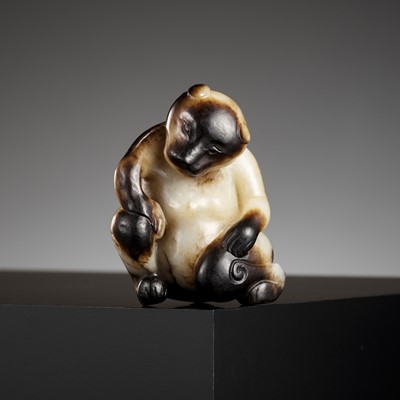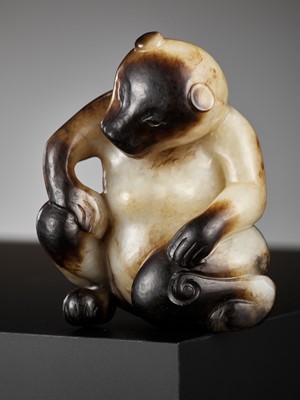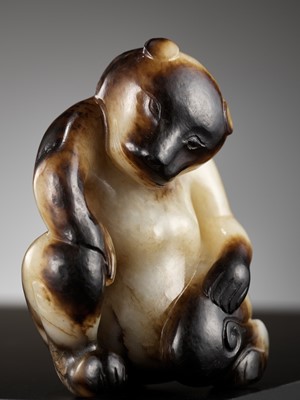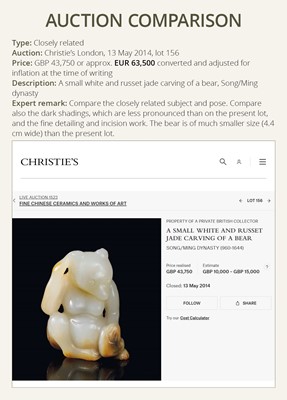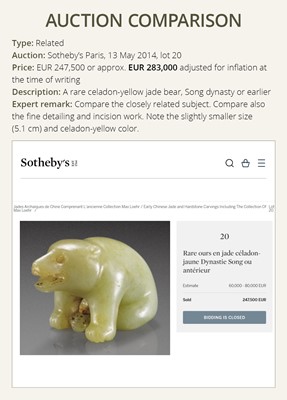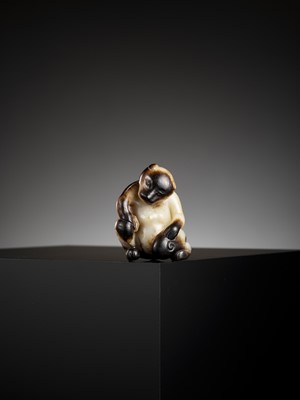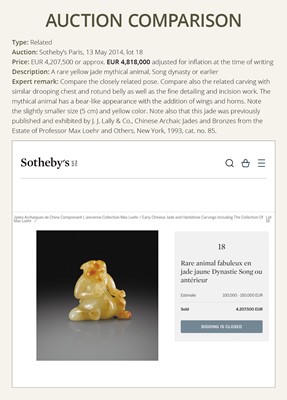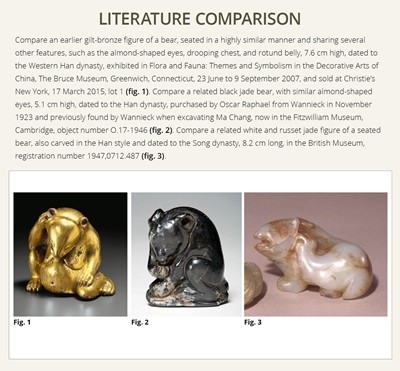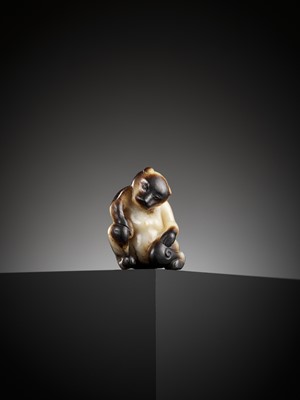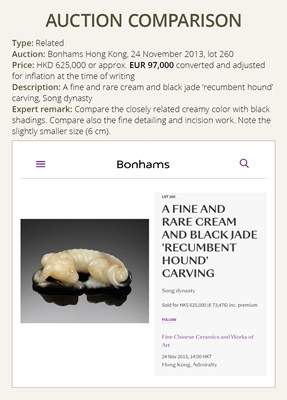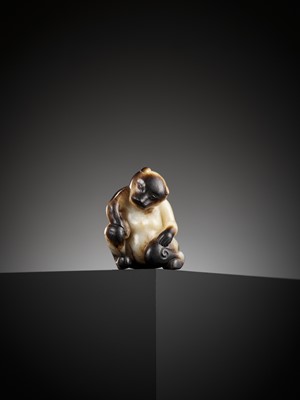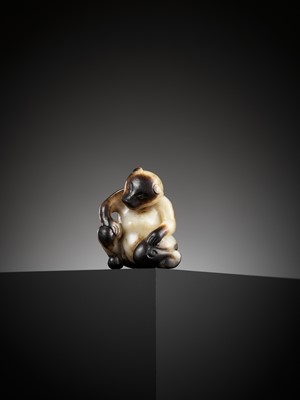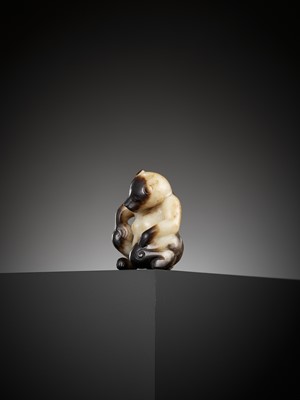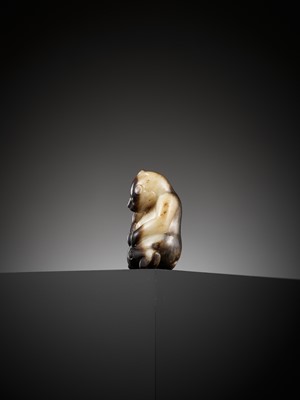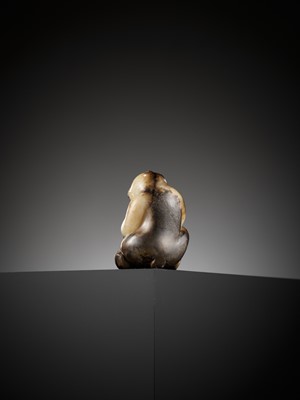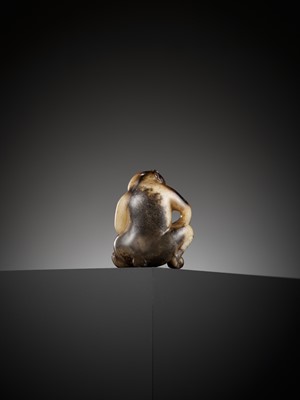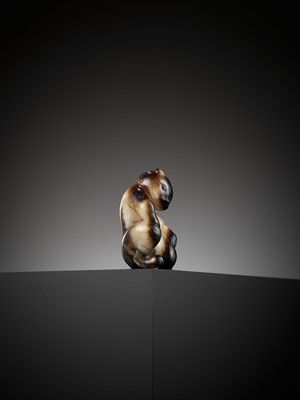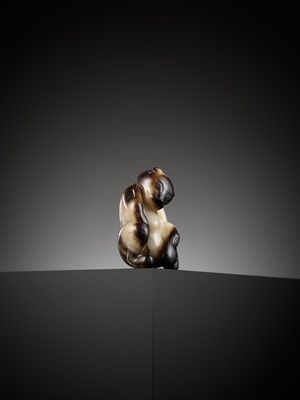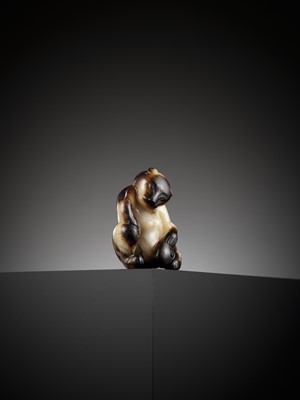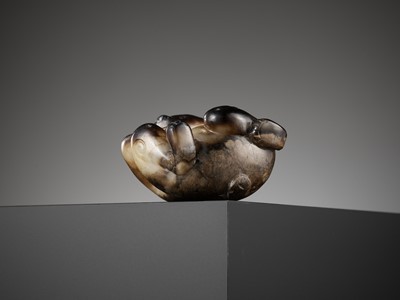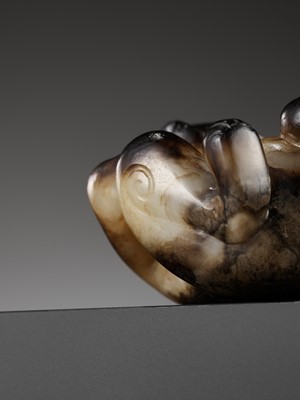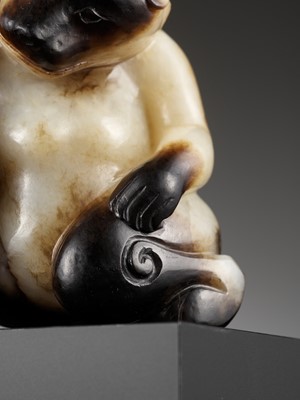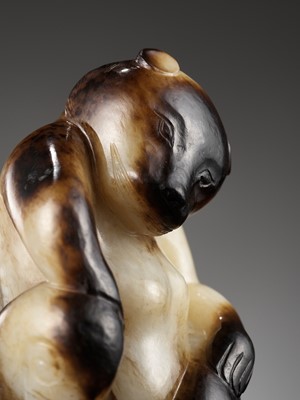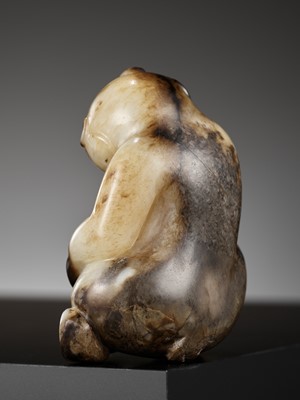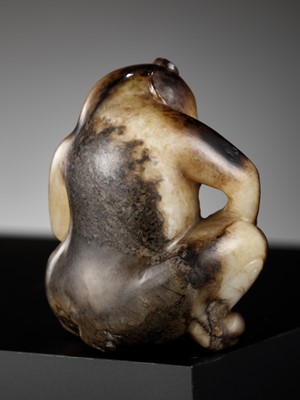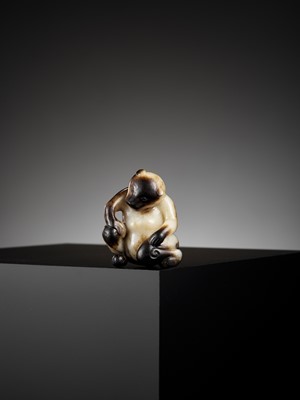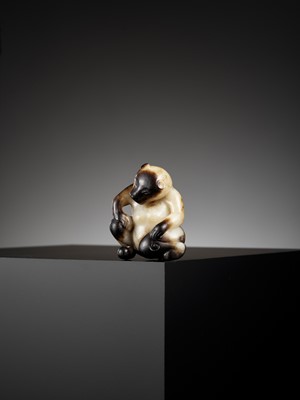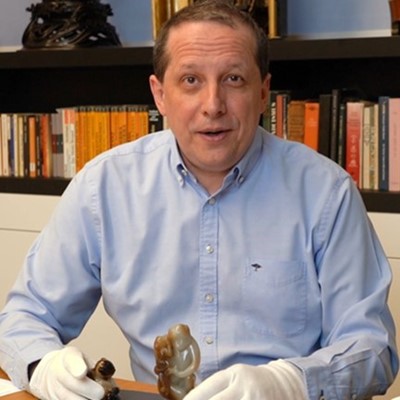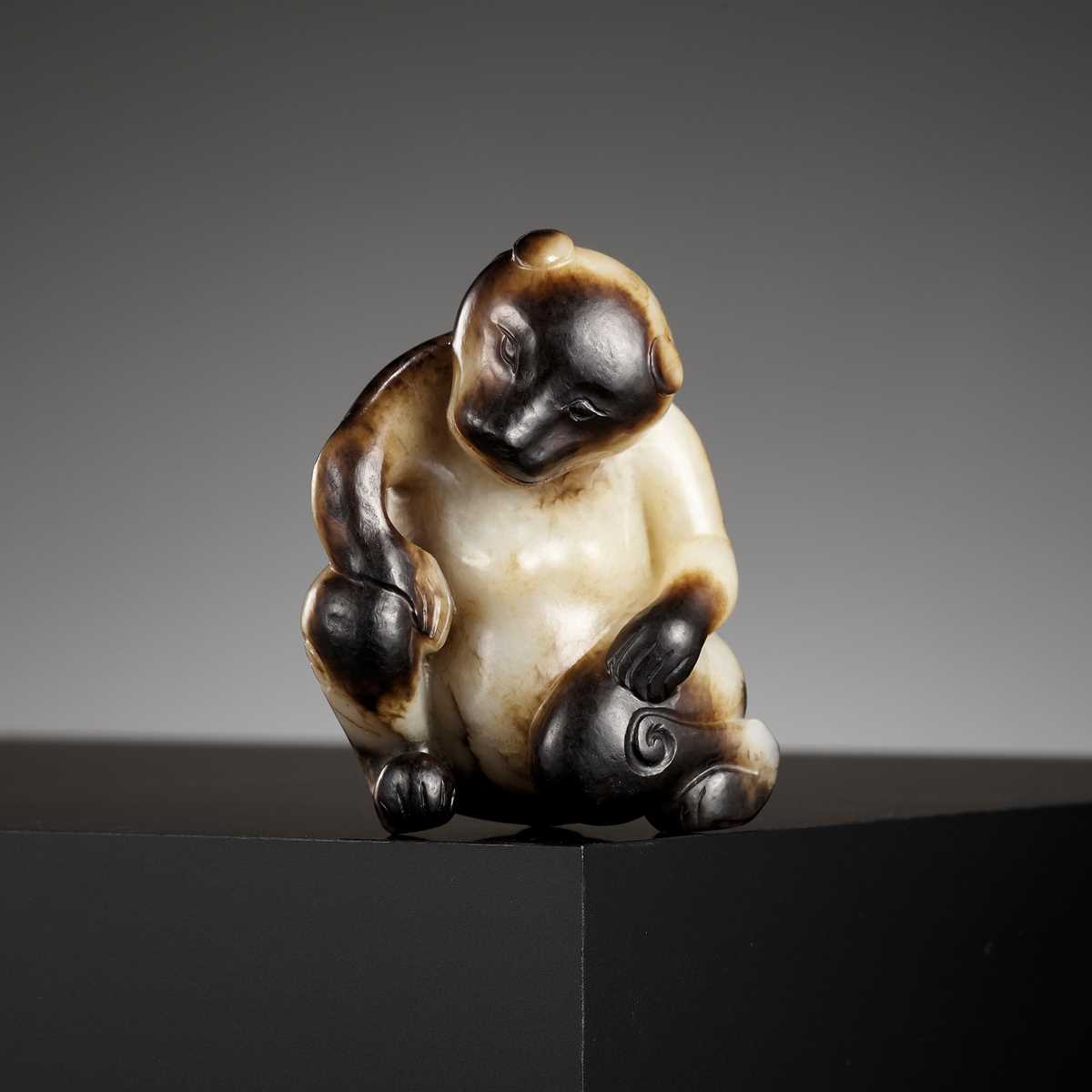9th Mar, 2023 13:00
TWO-DAY AUCTION - Fine Chinese Art / 中國藝術集珍 / Buddhism & Hinduism
35
AN EXCEPTIONAL CREAMY-WHITE AND BLACK JADE FIGURE OF A BEAR, SONG DYNASTY OR EARLIER
宋代或更早玉熊
Sold for €31,200
including Buyer's Premium
China, 960-1279 or earlier. Powerfully and sensitively carved. The mighty yet gentle animal seated with the knees and elbows bent, the hands resting on the legs, the lowered head slightly turned to the left, evoking a pensive state of mind. The body with slightly drooping chest and rotund belly. The lower legs are accented with a neatly incised scroll below each knee, while the clawed paws and short tail are finely incised as well. The face is well detailed with almond-shaped eyes, a long muzzle and snout, thin lips framing rows of teeth, and subtle fur markings incised to the ruff.
Provenance: From the private collection of Adrianus Verhelst, Netherlands. Adrianus Cornelis Maria Verhelst (b. 1955) is a retired Dutch entrepreneur and manager, stemming from the Verhelst family, who served as a director of Verlascon Management, a noted financial holding company based in Roosendaal, Netherlands. He was a passionate and discerning collector of Chinese and Buddhist art, displaying some of his pieces prominently across the family properties in the Netherlands, Belgium, and England.
Condition: Very good condition commensurate with age, showing old wear, microscopic nicks here and there, few small areas with minuscule age-related losses, smoothened over time. The stone with natural fissures, some of which have developed into small hairline cracks over time, consistent with jade figures dating from the Song dynasty. The stone with a smooth, unctuous feel overall, the result of centuries of gentle handling.
Weight: 237.3 g
Dimensions: Height 7.5 cm, Width 6 cm
The superbly polished, translucent stone is of a creamy white, somewhat yellowish tone with brownish-black shadings ingeniously incorporated into the carving, as well as russet and black veins, and cloudy inclusions.
The bear has been a popular totemic emblem in China since ancient times. China's foundation myths hold that the legendary Yellow Emperor, or Huang Di, early on lived with his tribe in the northwest, presumably in modern Shanxi Province, but then later migrated to Zhuolu, in present-day Hebei Province, where he became a farmer and tamed six different types of ferocious beasts, including the bear, or xiong, with which the Yellow Emperor ever since has been linked. According to legend, Gun — said to have been the great-grandson of the Yellow Emperor and the father of Yu the Great, or Da Yu — stole a special soil with which he planned to build dikes in an attempt to control the Yellow River's constantly recurring and very devastating floods. He failed in his mission, however, and, as punishment for his theft, was killed by Zhurong, the God of Fire. Gun's corpse turned into a yellow bear, or huangxiong, and jumped into a pool. A while later, a golden bear, alternatively said to be a golden dragon, emerged from the corpse's stomach and ascended into heaven, where the Yellow Emperor instructed it to complete his father's work in taming the Yellow River's waters. That bear turned out to be Da Yu, who — according to popular belief — heroically controlled the floods and became the mythological forefather of China's Xia dynasty. Therefore, the bear has been prominently associated with legendary rulers and Chinese national foundation myths since the earliest times.
Bears are native to China, their presence there known since antiquity. They were kept in Han imperial zoos and parks, where the emperor and his entourage enjoyed watching them in performance or in combat with other animals. On the other hand, they were perceived as enlightened creatures and it was believed that they resided in spiritual mountains and possessed the ability to intermediate between heaven and earth. Bears have also been linked with military prowess, shamanism, and immortality. As a corollary, it might be noted that the words for 'bear' and 'virility' are exact homonyms, pronounced xiong. According to the 'Rites of Zhou', Zhou Li, edited during the Han dynasty, bears were employed in exorcism rituals, their skin worn over the head of the performer who, holding a lance and a shield, led the officials to perform the Seasonal Exorcism by searching through houses and driving away pestilences. See J. Lagerway, Early Chinese Religion. Part One. Shang through Han (1250 BC-220 AD), Boston, 2008, page 287.
In ancient China, immortality was often considered the ultimate pursuit for royalty. The First Emperor who united the country in 221 BC is known to have sent expeditions into the eastern sea in search of Penglai, a mountainous island shrouded in a mysterious cloud, which at the time was believed to be the home of immortals, where elixirs of immortality could be retrieved. Once every 99th year, an immortal from this mysterious island would descend to the earthly realm and bestow immortality upon a select few. These immortals were believed to take the form of carved jade animals, for example bears.
Jade was the only material in which these mythological epitomes were believed to exist. This conviction is probably due to the near-indestructible quality of the mineral, which would make such a carving outlive every human being. When inhabited by an immortal, the jade would have looked almost fully translucent, especially when held against strong moonlight. According to ancient creed, the owner of such a magical jade animal was ensured an extended life. By having everyday contact with the object through rubbing its surface, the power of the inhabiting immortal would slowly be transferred to its owner. Highly sought after by the rich and wealthy, a jade animal as such was extremely rare and thus widely copied throughout Chinese history, particularly during the Song and Ming dynasties.
Evidence of this rich tradition of craftsmanship has been transmitted down through a small number of exquisite carvings, of which the present jade bear is a fine example. The craftsman has made good use of the lustrous colored stone in which the contours have been so skillfully and compactly utilized to depict the form of a seated bear. While it is superbly rendered, it lacks some of the ferocity of Han examples, being of a more benign appearance, thus pointing to a date closer to the Song dynasty when a deliberate revival of ancient styles and forms was behind some of these marvelous carvings of jade animals.
Literature comparison:
Compare an earlier gilt-bronze figure of a bear, seated in a highly similar manner and sharing several other features, such as the almond-shaped eyes, drooping chest, and rotund belly, 7.6 cm high, dated to the Western Han dynasty, exhibited in Flora and Fauna: Themes and Symbolism in the Decorative Arts of China, The Bruce Museum, Greenwich, Connecticut, 23 June to 9 September 2007, and sold at Christie’s New York, 17 March 2015, lot 1. Compare a related black jade bear, with similar almond-shaped eyes, 5.1 cm high, dated to the Han dynasty, purchased by Oscar Raphael from Wannieck in November 1923 and previously found by Wannieck when excavating Ma Chang, now in the Fitzwilliam Museum, Cambridge, object number O.17-1946. Compare a related white and russet jade figure of a seated bear, also carved in the Han style and dated to the Song dynasty, 8.2 cm long, in the British Museum, registration number 1947,0712.487.
Auction result comparison:
Type: Closely related
Auction: Christie’s London, 13 May 2014, lot 156
Price: GBP 43,750 or approx. EUR 63,500 converted and adjusted for inflation at the time of writing
Description: A small white and russet jade carving of a bear, Song/Ming dynasty
Expert remark: Compare the closely related subject and pose. Compare also the dark shadings, which are less pronounced than on the present lot, and the fine detailing and incision work. The bear is of much smaller size (4.4 cm wide) than the present lot.
Auction result comparison:
Type: Related
Auction: Bonhams Hong Kong, 24 November 2013, lot 260
Price: HKD 625,000 or approx. EUR 97,000 converted and adjusted for inflation at the time of writing
Description: A fine and rare cream and black jade ‘recumbent hound’ carving, Song dynasty
Expert remark: Compare the closely related creamy color with black shadings. Compare also the fine detailing and incision work. Note the slightly smaller size (6 cm).
Auction result comparison:
Type: Related
Auction: Sotheby’s Paris, 13 May 2014, lot 20
Price: EUR 247,500 or approx. EUR 283,000 adjusted for inflation at the time of writing
Description: A rare celadon-yellow jade bear, Song dynasty or earlier
Expert remark: Compare the closely related subject. Compare also the fine detailing and incision work. Note the slightly smaller size (5.1 cm) and celadon-yellow color.
Auction result comparison:
Type: Related
Auction: Sotheby’s Paris, 13 May 2014, lot 18
Price: EUR 4,207,500 or approx. EUR 4,818,000 adjusted for inflation at the time of writing
Description: A rare yellow jade mythical animal, Song dynasty or earlier
Expert remark: Compare the closely related pose. Compare also the related carving with similar drooping chest and rotund belly as well as the fine detailing and incision work. The mythical animal has a bear-like appearance with the addition of wings and horns. Note the slightly smaller size (5 cm) and yellow color. Note also that this jade was previously published and exhibited by J. J. Lally & Co., Chinese Archaic Jades and Bronzes from the Estate of Professor Max Loehr and Others, New York, 1993, cat. no. 85.
宋代或更早玉熊
中國,960-1279 年或更早。局部有深褐色沁。熊形鎮圓雕琢成坐姿,頭微微偏向左側,尖首圓眼,雙耳後抿,體態肥碩,屈膝屈肘,呈現悠閒之態,形象自然生動。
來源:荷蘭Adrianus Verhelst私人收藏。Adrianus Cornelis Maria Verhelst (1955年出生) 是一位退休的荷蘭企業家和經理,出身於 Verhelst 家族,曾擔任位於荷蘭羅森達爾的著名金融控股公司 Verlascon Management 的董事。 他是中國和佛教藝術品的忠實收藏家。在荷蘭、比利時和英國的家族財產中突出展示了他的一些藏品。
品相:品相良好,有磨損和微小刻痕和磕損,隨著時間的推移變得平滑。玉料有天然裂隙,隨著時間的推移,其中一些已經發展成細小的裂紋。整體光滑瑩潤。
重量:237.3 克
尺寸:高 7.5 厘米,寬 6 厘米
半透明玉料呈乳白色,略帶淡黃色調,巧妙利用棕黑色以及赤褐色紋理,有絮狀物。
熊自古以來就是中國圖騰象徵。在中國神話中,黃帝早年與他的部落一起生活在西北,大概在今山西省,後來遷移到今河北省的涿鹿,在那裡他馴服了六種不同的猛獸,包括熊。自此黃帝就與熊聯繫在一起。據說,鯀——黃帝的曾孫和大禹的父親——偷了一種特殊的土壤,他計劃用這種土壤建造堤壩,以試圖整治黃河洪水。然而,他失敗了,作為對他懲罰,他被火神祝融殺死了。鯀的屍體變成了一隻黃熊,跳進了水裡。 過了一會兒,一隻金熊,或者說是一條金龍,從屍體的肚子裡出來升天,黃帝吩咐它完成治理黃河的工作。那隻熊原來是大禹,他英勇地治水成功,成為了中國夏朝神話中的始祖。 因此,熊自古以來就與傳奇的統治者和中華民族的神話有著密切的聯繫。
熊原來自中國,在漢代皇家動物園和公園中就曾飼養過熊。皇帝和他的隨從們喜歡在那裡觀看它們表演或與其他動物搏鬥。 另一方面,熊被認為是開明的生物,人們相信他們居住在靈山中,具有介於天地之間的能力。熊也與軍事實力、薩滿教和死亡有關。到熊和雄這兩個字發音相同。據漢代編纂的《周禮》記載,熊被用於驅魔儀式,熊的皮戴在表演者的頭上,表演者手持長槍和盾牌,驅除瘟疫來驅魔。 見 J. Lagerway,Early Chinese Religion,第一部分,商至漢(公元前 1250 年 - 公元 220 年),波士頓,2008年 年,第 287 頁。
在中國古代,死而復生常被認為是皇室的終極追求。統一國家的秦始皇曾派遣遠征隊進入東海尋找蓬萊,每隔 99 年,來自這個神秘島嶼的神仙就會降臨人間並選擇一些凡人。人們認為這些凡人採用玉雕動物的形式,例如熊。
玉是唯一被認為存在這些神話縮影中的材料。這種信念可能是由於礦物幾乎堅不可摧的品質。玉石看起來幾乎是半透明的,尤其是在強烈的月光下。傳説,這種神奇的玉獸的主人可以得到長壽。通過摩擦物體的表面與物體進行日常接觸,抑制異獸的力量會慢慢轉移到它的主人身上。 由於受到富人追捧,這種玉質動物極為稀有,因此在整個中國歷史上被廣泛複製,尤其是在宋代和明代。
這種工藝傳統已通過少量精美的雕刻品傳承下來,本玉熊就是其中的一個很好的例子。工匠巧妙利用材料勾勒出熊的坐姿。它沒有漢代玉熊的兇猛,外觀更溫和,因此更接近宋代風格。
文獻比較:
比較一件西漢鎏金銅熊形擺件,高度相似的雕刻風格和幾處特色,例如杏仁狀眼、下垂的胸形、圓凸的肚子,2007年6月23日至9月9日展覽於康乃狄格格林尼治的The Bruce Museum,《 Flora and Fauna: Themes and Symbolism in the Decorative Arts of China》,售於紐約佳士得,2015年3月17日,lot 1。比較一件相近漢代黑玉熊形擺件,有相似的杏仁眼,5.1 厘米高, 1923 年11月購於Oscar Raphael from Wannieck,Wannieck發現於Ma Chang遺址,現藏於劍橋Fitzwilliam Museum,館藏編號O.17-1946。比較一件相近的宋代仿漢代風格白玉帶皮坐熊,8.2 厘米長,收藏於大英博物館,館藏編號1947,0712.487。
拍賣結果比較:
形制:非常相近
拍賣:倫敦佳士得,2014年5月13日,lot 156
價格:GBP 43,750(相當於今日EUR 63,500)
描述:宋 / 元白玉帶皮坐熊
專家評論:比較非常相近的主題和姿勢、黑色紋理,以及精美的雕刻細節。 此坐熊尺寸較小(4.4 厘米寬)。
拍賣結果比較:
形制:相近
拍賣:香港邦瀚斯,2013年11月24日,lot 260
價格:HKD 625,000(相當於今日EUR 97,000)
描述:宋黑白玉雕卧狗
專家評論:比較非常相近的乳白色玉石和黑色紋理,以及精細的雕刻細節。請注意尺寸稍小(6 厘米)。
拍賣結果比較:
形制:相近
拍賣:巴黎蘇富比,2014年5月13日,lot 20
價格:EUR 247,500(相當於今日EUR 283,000)
描述:宋或更早期黃青玉熊
專家評論:比較非常相近的主題。比較精細的雕刻細節。請注意尺寸稍小(5.1 厘米) 和青黃玉石調。
拍賣結果比較:
形制:相近
拍賣:巴黎蘇富比,2014年5月13日,lot 18
價格:EUR 4,207,500(相當於今日EUR 4,818,000)
描述:宋或更早期黃玉神獸
專家評論:比較非常相近的姿勢。比較相近的雕刻,例如下垂的胸形、圓凸的肚子,以及精細的雕刻細節。此神獸具有熊般的外觀,並增加了翅膀和角。請注意尺寸稍小(5 厘米)和黃玉顏色。請注意此玉曾出版和展覽於 J. J. Lally & Co.,《Chinese Archaic Jades and Bronzes from the Estate of Professor Max Loehr and Others》,紐約,1993年,圖錄編號85。
China, 960-1279 or earlier. Powerfully and sensitively carved. The mighty yet gentle animal seated with the knees and elbows bent, the hands resting on the legs, the lowered head slightly turned to the left, evoking a pensive state of mind. The body with slightly drooping chest and rotund belly. The lower legs are accented with a neatly incised scroll below each knee, while the clawed paws and short tail are finely incised as well. The face is well detailed with almond-shaped eyes, a long muzzle and snout, thin lips framing rows of teeth, and subtle fur markings incised to the ruff.
Provenance: From the private collection of Adrianus Verhelst, Netherlands. Adrianus Cornelis Maria Verhelst (b. 1955) is a retired Dutch entrepreneur and manager, stemming from the Verhelst family, who served as a director of Verlascon Management, a noted financial holding company based in Roosendaal, Netherlands. He was a passionate and discerning collector of Chinese and Buddhist art, displaying some of his pieces prominently across the family properties in the Netherlands, Belgium, and England.
Condition: Very good condition commensurate with age, showing old wear, microscopic nicks here and there, few small areas with minuscule age-related losses, smoothened over time. The stone with natural fissures, some of which have developed into small hairline cracks over time, consistent with jade figures dating from the Song dynasty. The stone with a smooth, unctuous feel overall, the result of centuries of gentle handling.
Weight: 237.3 g
Dimensions: Height 7.5 cm, Width 6 cm
The superbly polished, translucent stone is of a creamy white, somewhat yellowish tone with brownish-black shadings ingeniously incorporated into the carving, as well as russet and black veins, and cloudy inclusions.
The bear has been a popular totemic emblem in China since ancient times. China's foundation myths hold that the legendary Yellow Emperor, or Huang Di, early on lived with his tribe in the northwest, presumably in modern Shanxi Province, but then later migrated to Zhuolu, in present-day Hebei Province, where he became a farmer and tamed six different types of ferocious beasts, including the bear, or xiong, with which the Yellow Emperor ever since has been linked. According to legend, Gun — said to have been the great-grandson of the Yellow Emperor and the father of Yu the Great, or Da Yu — stole a special soil with which he planned to build dikes in an attempt to control the Yellow River's constantly recurring and very devastating floods. He failed in his mission, however, and, as punishment for his theft, was killed by Zhurong, the God of Fire. Gun's corpse turned into a yellow bear, or huangxiong, and jumped into a pool. A while later, a golden bear, alternatively said to be a golden dragon, emerged from the corpse's stomach and ascended into heaven, where the Yellow Emperor instructed it to complete his father's work in taming the Yellow River's waters. That bear turned out to be Da Yu, who — according to popular belief — heroically controlled the floods and became the mythological forefather of China's Xia dynasty. Therefore, the bear has been prominently associated with legendary rulers and Chinese national foundation myths since the earliest times.
Bears are native to China, their presence there known since antiquity. They were kept in Han imperial zoos and parks, where the emperor and his entourage enjoyed watching them in performance or in combat with other animals. On the other hand, they were perceived as enlightened creatures and it was believed that they resided in spiritual mountains and possessed the ability to intermediate between heaven and earth. Bears have also been linked with military prowess, shamanism, and immortality. As a corollary, it might be noted that the words for 'bear' and 'virility' are exact homonyms, pronounced xiong. According to the 'Rites of Zhou', Zhou Li, edited during the Han dynasty, bears were employed in exorcism rituals, their skin worn over the head of the performer who, holding a lance and a shield, led the officials to perform the Seasonal Exorcism by searching through houses and driving away pestilences. See J. Lagerway, Early Chinese Religion. Part One. Shang through Han (1250 BC-220 AD), Boston, 2008, page 287.
In ancient China, immortality was often considered the ultimate pursuit for royalty. The First Emperor who united the country in 221 BC is known to have sent expeditions into the eastern sea in search of Penglai, a mountainous island shrouded in a mysterious cloud, which at the time was believed to be the home of immortals, where elixirs of immortality could be retrieved. Once every 99th year, an immortal from this mysterious island would descend to the earthly realm and bestow immortality upon a select few. These immortals were believed to take the form of carved jade animals, for example bears.
Jade was the only material in which these mythological epitomes were believed to exist. This conviction is probably due to the near-indestructible quality of the mineral, which would make such a carving outlive every human being. When inhabited by an immortal, the jade would have looked almost fully translucent, especially when held against strong moonlight. According to ancient creed, the owner of such a magical jade animal was ensured an extended life. By having everyday contact with the object through rubbing its surface, the power of the inhabiting immortal would slowly be transferred to its owner. Highly sought after by the rich and wealthy, a jade animal as such was extremely rare and thus widely copied throughout Chinese history, particularly during the Song and Ming dynasties.
Evidence of this rich tradition of craftsmanship has been transmitted down through a small number of exquisite carvings, of which the present jade bear is a fine example. The craftsman has made good use of the lustrous colored stone in which the contours have been so skillfully and compactly utilized to depict the form of a seated bear. While it is superbly rendered, it lacks some of the ferocity of Han examples, being of a more benign appearance, thus pointing to a date closer to the Song dynasty when a deliberate revival of ancient styles and forms was behind some of these marvelous carvings of jade animals.
Literature comparison:
Compare an earlier gilt-bronze figure of a bear, seated in a highly similar manner and sharing several other features, such as the almond-shaped eyes, drooping chest, and rotund belly, 7.6 cm high, dated to the Western Han dynasty, exhibited in Flora and Fauna: Themes and Symbolism in the Decorative Arts of China, The Bruce Museum, Greenwich, Connecticut, 23 June to 9 September 2007, and sold at Christie’s New York, 17 March 2015, lot 1. Compare a related black jade bear, with similar almond-shaped eyes, 5.1 cm high, dated to the Han dynasty, purchased by Oscar Raphael from Wannieck in November 1923 and previously found by Wannieck when excavating Ma Chang, now in the Fitzwilliam Museum, Cambridge, object number O.17-1946. Compare a related white and russet jade figure of a seated bear, also carved in the Han style and dated to the Song dynasty, 8.2 cm long, in the British Museum, registration number 1947,0712.487.
Auction result comparison:
Type: Closely related
Auction: Christie’s London, 13 May 2014, lot 156
Price: GBP 43,750 or approx. EUR 63,500 converted and adjusted for inflation at the time of writing
Description: A small white and russet jade carving of a bear, Song/Ming dynasty
Expert remark: Compare the closely related subject and pose. Compare also the dark shadings, which are less pronounced than on the present lot, and the fine detailing and incision work. The bear is of much smaller size (4.4 cm wide) than the present lot.
Auction result comparison:
Type: Related
Auction: Bonhams Hong Kong, 24 November 2013, lot 260
Price: HKD 625,000 or approx. EUR 97,000 converted and adjusted for inflation at the time of writing
Description: A fine and rare cream and black jade ‘recumbent hound’ carving, Song dynasty
Expert remark: Compare the closely related creamy color with black shadings. Compare also the fine detailing and incision work. Note the slightly smaller size (6 cm).
Auction result comparison:
Type: Related
Auction: Sotheby’s Paris, 13 May 2014, lot 20
Price: EUR 247,500 or approx. EUR 283,000 adjusted for inflation at the time of writing
Description: A rare celadon-yellow jade bear, Song dynasty or earlier
Expert remark: Compare the closely related subject. Compare also the fine detailing and incision work. Note the slightly smaller size (5.1 cm) and celadon-yellow color.
Auction result comparison:
Type: Related
Auction: Sotheby’s Paris, 13 May 2014, lot 18
Price: EUR 4,207,500 or approx. EUR 4,818,000 adjusted for inflation at the time of writing
Description: A rare yellow jade mythical animal, Song dynasty or earlier
Expert remark: Compare the closely related pose. Compare also the related carving with similar drooping chest and rotund belly as well as the fine detailing and incision work. The mythical animal has a bear-like appearance with the addition of wings and horns. Note the slightly smaller size (5 cm) and yellow color. Note also that this jade was previously published and exhibited by J. J. Lally & Co., Chinese Archaic Jades and Bronzes from the Estate of Professor Max Loehr and Others, New York, 1993, cat. no. 85.
宋代或更早玉熊
中國,960-1279 年或更早。局部有深褐色沁。熊形鎮圓雕琢成坐姿,頭微微偏向左側,尖首圓眼,雙耳後抿,體態肥碩,屈膝屈肘,呈現悠閒之態,形象自然生動。
來源:荷蘭Adrianus Verhelst私人收藏。Adrianus Cornelis Maria Verhelst (1955年出生) 是一位退休的荷蘭企業家和經理,出身於 Verhelst 家族,曾擔任位於荷蘭羅森達爾的著名金融控股公司 Verlascon Management 的董事。 他是中國和佛教藝術品的忠實收藏家。在荷蘭、比利時和英國的家族財產中突出展示了他的一些藏品。
品相:品相良好,有磨損和微小刻痕和磕損,隨著時間的推移變得平滑。玉料有天然裂隙,隨著時間的推移,其中一些已經發展成細小的裂紋。整體光滑瑩潤。
重量:237.3 克
尺寸:高 7.5 厘米,寬 6 厘米
半透明玉料呈乳白色,略帶淡黃色調,巧妙利用棕黑色以及赤褐色紋理,有絮狀物。
熊自古以來就是中國圖騰象徵。在中國神話中,黃帝早年與他的部落一起生活在西北,大概在今山西省,後來遷移到今河北省的涿鹿,在那裡他馴服了六種不同的猛獸,包括熊。自此黃帝就與熊聯繫在一起。據說,鯀——黃帝的曾孫和大禹的父親——偷了一種特殊的土壤,他計劃用這種土壤建造堤壩,以試圖整治黃河洪水。然而,他失敗了,作為對他懲罰,他被火神祝融殺死了。鯀的屍體變成了一隻黃熊,跳進了水裡。 過了一會兒,一隻金熊,或者說是一條金龍,從屍體的肚子裡出來升天,黃帝吩咐它完成治理黃河的工作。那隻熊原來是大禹,他英勇地治水成功,成為了中國夏朝神話中的始祖。 因此,熊自古以來就與傳奇的統治者和中華民族的神話有著密切的聯繫。
熊原來自中國,在漢代皇家動物園和公園中就曾飼養過熊。皇帝和他的隨從們喜歡在那裡觀看它們表演或與其他動物搏鬥。 另一方面,熊被認為是開明的生物,人們相信他們居住在靈山中,具有介於天地之間的能力。熊也與軍事實力、薩滿教和死亡有關。到熊和雄這兩個字發音相同。據漢代編纂的《周禮》記載,熊被用於驅魔儀式,熊的皮戴在表演者的頭上,表演者手持長槍和盾牌,驅除瘟疫來驅魔。 見 J. Lagerway,Early Chinese Religion,第一部分,商至漢(公元前 1250 年 - 公元 220 年),波士頓,2008年 年,第 287 頁。
在中國古代,死而復生常被認為是皇室的終極追求。統一國家的秦始皇曾派遣遠征隊進入東海尋找蓬萊,每隔 99 年,來自這個神秘島嶼的神仙就會降臨人間並選擇一些凡人。人們認為這些凡人採用玉雕動物的形式,例如熊。
玉是唯一被認為存在這些神話縮影中的材料。這種信念可能是由於礦物幾乎堅不可摧的品質。玉石看起來幾乎是半透明的,尤其是在強烈的月光下。傳説,這種神奇的玉獸的主人可以得到長壽。通過摩擦物體的表面與物體進行日常接觸,抑制異獸的力量會慢慢轉移到它的主人身上。 由於受到富人追捧,這種玉質動物極為稀有,因此在整個中國歷史上被廣泛複製,尤其是在宋代和明代。
這種工藝傳統已通過少量精美的雕刻品傳承下來,本玉熊就是其中的一個很好的例子。工匠巧妙利用材料勾勒出熊的坐姿。它沒有漢代玉熊的兇猛,外觀更溫和,因此更接近宋代風格。
文獻比較:
比較一件西漢鎏金銅熊形擺件,高度相似的雕刻風格和幾處特色,例如杏仁狀眼、下垂的胸形、圓凸的肚子,2007年6月23日至9月9日展覽於康乃狄格格林尼治的The Bruce Museum,《 Flora and Fauna: Themes and Symbolism in the Decorative Arts of China》,售於紐約佳士得,2015年3月17日,lot 1。比較一件相近漢代黑玉熊形擺件,有相似的杏仁眼,5.1 厘米高, 1923 年11月購於Oscar Raphael from Wannieck,Wannieck發現於Ma Chang遺址,現藏於劍橋Fitzwilliam Museum,館藏編號O.17-1946。比較一件相近的宋代仿漢代風格白玉帶皮坐熊,8.2 厘米長,收藏於大英博物館,館藏編號1947,0712.487。
拍賣結果比較:
形制:非常相近
拍賣:倫敦佳士得,2014年5月13日,lot 156
價格:GBP 43,750(相當於今日EUR 63,500)
描述:宋 / 元白玉帶皮坐熊
專家評論:比較非常相近的主題和姿勢、黑色紋理,以及精美的雕刻細節。 此坐熊尺寸較小(4.4 厘米寬)。
拍賣結果比較:
形制:相近
拍賣:香港邦瀚斯,2013年11月24日,lot 260
價格:HKD 625,000(相當於今日EUR 97,000)
描述:宋黑白玉雕卧狗
專家評論:比較非常相近的乳白色玉石和黑色紋理,以及精細的雕刻細節。請注意尺寸稍小(6 厘米)。
拍賣結果比較:
形制:相近
拍賣:巴黎蘇富比,2014年5月13日,lot 20
價格:EUR 247,500(相當於今日EUR 283,000)
描述:宋或更早期黃青玉熊
專家評論:比較非常相近的主題。比較精細的雕刻細節。請注意尺寸稍小(5.1 厘米) 和青黃玉石調。
拍賣結果比較:
形制:相近
拍賣:巴黎蘇富比,2014年5月13日,lot 18
價格:EUR 4,207,500(相當於今日EUR 4,818,000)
描述:宋或更早期黃玉神獸
專家評論:比較非常相近的姿勢。比較相近的雕刻,例如下垂的胸形、圓凸的肚子,以及精細的雕刻細節。此神獸具有熊般的外觀,並增加了翅膀和角。請注意尺寸稍小(5 厘米)和黃玉顏色。請注意此玉曾出版和展覽於 J. J. Lally & Co.,《Chinese Archaic Jades and Bronzes from the Estate of Professor Max Loehr and Others》,紐約,1993年,圖錄編號85。
Zacke Live Online Bidding
Our online bidding platform makes it easier than ever to bid in our auctions! When you bid through our website, you can take advantage of our premium buyer's terms without incurring any additional online bidding surcharges.
To bid live online, you'll need to create an online account. Once your account is created and your identity is verified, you can register to bid in an auction up to 12 hours before the auction begins.
Intended Spend and Bid Limits
When you register to bid in an online auction, you will need to share your intended maximum spending budget for the auction. We will then review your intended spend and set a bid limit for you. Once you have pre-registered for a live online auction, you can see your intended spend and bid limit by going to 'Account Settings' and clicking on 'Live Bidding Registrations'.
Your bid limit will be the maximum amount you can bid during the auction. Your bid limit is for the hammer price and is not affected by the buyer’s premium and VAT. For example, if you have a bid limit of €1,000 and place two winning bids for €300 and €200, then you will only be able to bid €500 for the rest of the auction. If you try to place a bid that is higher than €500, you will not be able to do so.
Online Absentee and Telephone Bids
You can now leave absentee and telephone bids on our website!
Absentee Bidding
Once you've created an account and your identity is verified, you can leave your absentee bid directly on the lot page. We will contact you when your bids have been confirmed.
Telephone Bidding
Once you've created an account and your identity is verified, you can leave telephone bids online. We will contact you when your bids have been confirmed.
Classic Absentee and Telephone Bidding Form
You can still submit absentee and telephone bids by email or fax if you prefer. Simply fill out the Absentee Bidding/Telephone bidding form and return it to us by email at office@zacke.at or by fax at +43 (1) 532 04 52 20. You can download the PDF from our Upcoming Auctions page.
How-To Guides
How to Create Your Personal Zacke Account
How to Register to Bid on Zacke Live
How to Leave Absentee Bids Online
How to Leave Telephone Bids Online
中文版本的操作指南
创建新账号
注册Zacke Live在线直播竞拍(免平台费)
缺席投标和电话投标
Third-Party Bidding
We partner with best-in-class third-party partners to make it easy for you to bid online in the channel of your choice. Please note that if you bid with one of our third-party online partners, then there will be a live bidding surcharge on top of your final purchase price. You can find all of our fees here. Here's a full list of our third-party partners:
- 51 Bid Live
- EpaiLive
- ArtFoxLive
- Invaluable
- LiveAuctioneers
- the-saleroom
- lot-tissimo
- Drouot
Please note that we place different auctions on different platforms. For example, in general, we only place Chinese art auctions on 51 Bid Live.
Bidding in Person
You must register to bid in person and will be assigned a paddle at the auction. Please contact us at office@zacke.at or +43 (1) 532 04 52 for the latest local health and safety guidelines.
